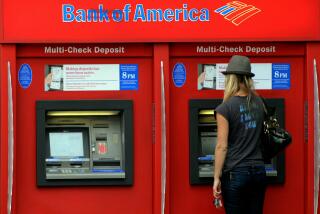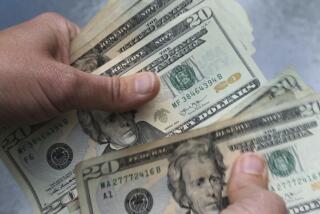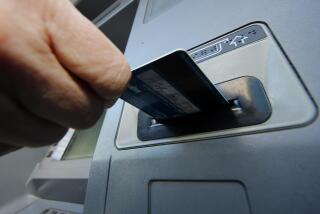Education That You Can Take to the Bank
Itâs not surprising that a group of third-graders in Los Angeles, given a little lesson on banks, were more interested in bank robbers than bankers. When pressed, they said banks were important because they hold money, and âif we did not have any money we would be poor.â
They donât know much more by the time they hit college and are greeted by myriad banks eager to give them not just checking accounts but credit cards. And all too many take the cards, because, as they tell their parents, âTheyâre free!â
Obviously, they get almost no education in money management before college and little more thereafter. How many grown-ups truly understand credit cards--grace periods, finance charges, their right to dispute billings? No wonder credit card spending is up, along with credit card debt, credit card delinquencies and personal bankruptcies. âOlder people come in (to banks) with not a clue to balancing a checkbook,â says Nancy Hermanson, personal service representative at First National Bank in Valley City, N.D.
One would think that schools could provide some personal finance along with personal hygiene and phys. ed., math and civics. Math texts cover dollars and cents, and sometimes even âconsumer math.â But they emphasize arithmetic formulas (assessing interest), not principles--calculation rather than application.
Into this information gap comes the private sector--a good thing, if schools remember to inspect the hand that feeds them. Some of the resultant âconsumer educationâ is blatantly commercial--nutrition posters featuring a particular brand, guides to dental health featuring particular toothpastes.
Some offerings are more objective. Consumers Union gives schools discounted (in some cases, free) magazines with study guides: Consumer Reports and Zillions, its childrenâs magazine. Zillions does emphasize purchase--product quality, price comparisons--with brief forays into questions of allowances and saving, but itâs a valid emphasis. The market for 4- to 12-year-olds now represents $75 billion a year in discretionary spending, $8 billion of it spent by kids themselves. Thatâs why the magazine, founded in 1980 as Penny Power, changed its name to Zillions last year.
But the care and handling of money is generally left to those in associated fields: banking, credit, investment, insurance, trade. So far, only bankers have taken up the challenge.
Much of whatâs put out isnât for kids at all, given the remedial needs of the whole population. But the childrenâs material is usually tailored to children. Citibankâs âDollars & Senseâ program increases in sophistication from fifth-grade level through college. Accompanied by glossaries of terms, wall posters and letters to parents, Citibankâs materials pose questions of budget and saving (snacks, bikes, boom boxes, for the youngest), loans and credit, even financial adversity (Dad loses his job; grandfather gets sick).
These are purely topics for discussion with âno right or wrongâ answers, says Kathy Frick, a teacher at Dunstan Jr. High in Jefferson County, Colo., and a 1991 Colorado Distinguished Teacher. The idea is involvement. As Frick says, itâs better âto send them home with two problems that they think and talk about than with 40 problems that have no meaning.â
Programs are available for younger children. The American Bankers Assn.âs Personal Economics Program provides local bankers with booklets, brochures and videos--even a comic book called âMeet the Bankâ for primary grades.
Much depends on the banker involved. Nancy Hermanson visits schools with such materials and also brings classes back to the bank for a tour, an ATM and check-writing demonstration and some basic information, such as: âYou canât write checks if you donât have any money.â
The Los Angeles third-graders above got ABA materials without Hermanson, and they still got the basic idea that banks mean safety for money. Some absorbed real economic principles: âIf banks are low on money,â said Andrew Bagg, now a fourth-grader, âtheyâll take some of yours and pay you back, giving you your money and some more besides, because they got to use yours.â Some parroted back the whole ABA pitch that âbanks help us, our families and our town to be happy, safe and well.â
Itâs the potential pitch that people fear. âThey were scared we were going to sell them on First National Bank,â Hermanson says.
But the bank, she says, only wants to make people more knowledgeable--an advantage all around--and âshow them that we care.â Citibank, which puts only its logo on the materials, states similar aims, wanting, says Richard Srednicki, general manager of its Visa and MasterCard division, to be âlooked at as a responsible corporate citizen.â
Whatever edge that gives them, it seems like a fair exchange.
More to Read
Inside the business of entertainment
The Wide Shot brings you news, analysis and insights on everything from streaming wars to production â and what it all means for the future.
You may occasionally receive promotional content from the Los Angeles Times.










